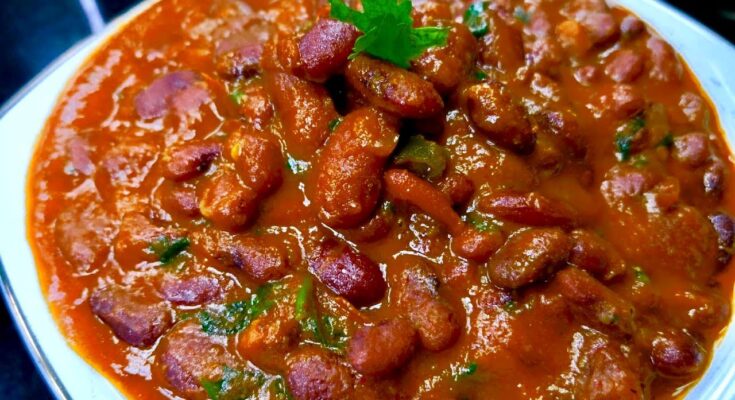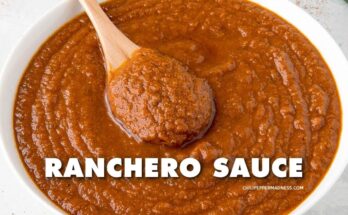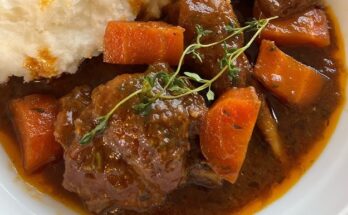Rajma Recipe: Rajma, or red kidney beans curry, is a staple comfort food in North Indian households. It’s warm, flavorful, hearty, and incredibly satisfying when paired with steamed rice, commonly known as “Rajma Chawal.” Whether it’s a lazy Sunday brunch or a festive gathering, Rajma always finds a spot on the table. This dish is more than just a meal—it’s an emotion for many. What makes it even better? It’s not just tasty, but packed with nutrition too. If you’re new to Indian cooking, this Rajma recipe is a great starting point. With its rich, aromatic gravy and melt-in-your-mouth beans, it promises to impress every time.
The Popularity of Rajma in Indian Cuisine
Rajma enjoys a legendary status in Indian kitchens. It’s especially beloved in states like Punjab, Himachal Pradesh, and Delhi. But what makes it so universally adored? Simplicity and soul. Unlike complex Mughlai dishes or heavily spiced curries, Rajma relies on a basic onion-tomato masala and everyday spices—yet the outcome is magical. It’s also incredibly versatile. Want to add cream for richness? Go ahead. Prefer it vegan with coconut milk? Absolutely. Pair it with rice or roti, make it soupy or thick—it never disappoints.
Health Benefits of Rajma
Beyond its flavor, rajma is a powerhouse of health. These red kidney beans are packed with plant-based protein, making them a favorite among vegetarians. They’re rich in dietary fiber, which aids digestion and keeps you full longer—perfect for weight management. Rajma is also loaded with essential nutrients like folate, magnesium, iron, and potassium. Regular consumption can help lower bad cholesterol, stabilize blood sugar levels, and support heart health. The best part? It’s naturally gluten-free and easy to adapt for vegan diets. Who said healthy food can’t be delicious?
Ingredients Needed for Rajma
Making the perfect Rajma begins with selecting the right ingredients. Freshness matters. High-quality spices and properly soaked beans are the secret to a good curry.
Basic Ingredients
Here’s a list of ingredients you need for a basic yet mouthwatering Rajma curry:
- 1 cup dried Rajma (red kidney beans)
- 2 tablespoons oil or ghee
- 1 large onion, finely chopped
- 2 medium tomatoes, pureed or finely chopped
- 1 tablespoon ginger-garlic paste
- 2 green chilies, slit
- 1 teaspoon cumin seeds
- 1 teaspoon turmeric powder
- 1 teaspoon red chili powder
- 1 teaspoon coriander powder
- 1/2 teaspoon garam masala
- Salt to taste
- Fresh coriander leaves for garnish
- 3-4 cups water (for pressure cooking)
These ingredients are readily available and likely already in your pantry if you cook Indian food regularly.
Optional Add-ons for Enhanced Flavor
If you’re looking to elevate your rajma to restaurant-style, consider these add-ons:
- 1/4 cup fresh cream or 1/2 cup coconut milk for creaminess
- Kasuri methi (dried fenugreek leaves) for a smoky touch
- Bay leaf or black cardamom while pressure cooking for deeper aroma
- Butter for finishing (especially if you love Punjabi-style rajma)
Each optional item brings a unique depth to the dish. You can skip or include them depending on your preference or dietary restrictions.
Preparing Rajma – Pre-Cooking Steps
Soaking Rajma the Right Way
Soaking is non-negotiable if you want soft, melt-in-the-mouth beans. Take 1 cup of rajma and rinse it thoroughly 2–3 times until the water runs clear. Then soak it in 3–4 cups of water for at least 8 hours or overnight. This step not only softens the beans but also removes phytic acid, which can hinder nutrient absorption. If you forget to soak it overnight, use hot water and soak for at least 3–4 hours.
After soaking, drain and rinse the beans once more before pressure cooking. Skipping this might make your rajma taste off or take longer to cook.
Boiling Tips for Soft and Creamy Beans
Boiling rajma is not just about softening it—it’s about achieving that perfect creamy texture. Transfer the soaked beans to a pressure cooker, add 3–4 cups of fresh water, a pinch of salt, and optionally a bay leaf or black cardamom for flavor. Cook it on high pressure for about 15–20 minutes (6–8 whistles), then let the pressure release naturally. Check a bean by pressing it between your fingers—it should mash easily.
If you’re using an Instant Pot, set it to “Bean/Chili” mode for 35 minutes. Avoid undercooked beans—they’re hard to digest and ruin the experience. Once cooked, don’t throw away the water; it’ll become part of your gravy base.
Making the Rajma Masala
Cooking the Onion-Tomato Base
The magic of Rajma lies in its masala. Heat oil or ghee in a large pan. Add cumin seeds and let them sizzle. Toss in chopped onions and sauté until golden brown. This can take around 10 minutes—don’t rush it. Browning the onions adds natural sweetness and depth. Add ginger-garlic paste and green chilies. Cook until the raw smell disappears.
Now, add your pureed tomatoes and a pinch of salt. Cook this mixture on medium heat for 10–15 minutes until oil starts to separate. This indicates the masala is well-cooked and ready for spices. Keep stirring occasionally to prevent burning.
Blending Spices Perfectly
Once your base is ready, it’s time to spice it up. Add turmeric, red chili, coriander powder, and a pinch of garam masala. Stir well and cook for another 3–5 minutes. This step helps the spices release their flavors. If the mixture looks dry, splash a bit of water. Your kitchen will smell divine by now—like the start of something amazing.
Finally, add the cooked rajma along with the water it was boiled in. Mix gently, allowing the beans to soak up the masala flavors. Let it simmer gently on low heat for 15–20 minutes. Stir occasionally and mash a few beans to thicken the curry naturally.
Simmering Rajma to Perfection
Balancing the Gravy
At this stage, you should have a thick, flavorful curry forming. But here’s the catch: consistency is everything. Too watery, and you’ll lose the essence; too thick, and it turns into a paste. The goal is a rich, luscious gravy that gently coats each bean. This is where the simmering magic happens. Lower the flame and let it cook uncovered for 15–20 minutes. The rajma will absorb all those wonderful spices and release some of its starch into the gravy, making it naturally creamy.
If you like your rajma a bit richer, you can add a tablespoon of cream or a cube of butter towards the end. Stir gently and taste. Adjust salt, chili, or garam masala if needed. Don’t be afraid to tweak it—every household has their own “perfect” rajma.
Cooking Time and Texture Check
Even though the beans were pressure-cooked earlier, this final simmer makes all the difference. It binds everything together and deepens the flavor profile. You’ll know it’s ready when the rajma is soft enough to break with a spoon but still holds its shape. Mashing a few beans into the gravy thickens it further without any extra thickeners. This trick gives you that restaurant-style finish.
Also, check if the gravy coats the back of your spoon without running. If yes, you’ve nailed the texture. If it’s still watery, simmer a bit longer. Conversely, if it’s too thick, add a splash of hot water and stir it in. Lastly, sprinkle in some freshly chopped coriander leaves—it adds a fresh, herbal note that beautifully finishes the dish.
Serving Suggestions and Pairings
Rajma Chawal – The Classic Combo
Now that your rajma is ready, it’s time to serve it the traditional way—with plain steamed basmati rice. Rajma Chawal is a match made in heaven, offering the perfect balance of carbs and protein. Spoon the hot rajma over a mound of fluffy rice, drizzle with ghee if desired, and enjoy with a side of pickled onions or green chili. For many, this combo is not just food; it’s nostalgia served on a plate.
Want to elevate it? Add a bowl of raita (yogurt with herbs and spices) and some papad on the side. The coolness of raita pairs wonderfully with the warmth of rajma, creating a well-rounded meal.
Alternative Serving Options
While rice is the traditional partner, rajma is incredibly flexible. Here are some tasty alternatives:
- Jeera Rice: Infused with cumin, this adds a subtle flavor that enhances rajma beautifully.
- Roti or Paratha: Soft Indian bread works great for scooping up the curry.
- Quinoa or Brown Rice: For a healthier twist, pair rajma with high-fiber grains.
- Baked Potatoes: Scoop rajma over a baked potato and top with cheese for a fusion twist.
- Tacos or Wraps: Use it as a filling for a spicy vegetarian wrap or taco.
These options are perfect when you want to switch things up or use leftovers creatively.
Tips for the Best Rajma Every Time
Common Mistakes to Avoid
Even seasoned cooks can mess up rajma if they’re not careful. One of the most common mistakes is undercooking the beans. This ruins the texture and makes the dish harder to digest. Always test a few beans after pressure cooking—they should mash easily with your fingers. Another issue is rushing the masala. If your onion-tomato base isn’t properly cooked, the gravy will taste raw or sour. Always cook until oil separates for the richest flavor.
Using too many spices or not toasting them correctly is another problem. Remember, less is more when it comes to masala. Let the spices toast well to release their aroma. And don’t forget to adjust seasoning after simmering; rajma thickens as it sits, and you might need a bit more salt or spice.
How to Store and Reheat Rajma
Rajma tastes even better the next day! Store any leftovers in an airtight container in the fridge for up to 3 days. The flavors continue to deepen overnight. For freezing, let it cool completely before transferring to a freezer-safe container. It can be frozen for up to 1 month.
When reheating, always use a stovetop if possible. Add a splash of water to loosen the gravy and warm it gently over low heat. Avoid microwaving if you can—it tends to dry out the gravy and heat unevenly. If using a microwave, stir halfway through and reheat in short bursts.
Variations of Rajma You Should Try
Punjabi-Style Rajma
The Punjabi version is rich, spicy, and full of bold flavors. It often includes extra ghee, butter, or cream, along with a dash of kasuri methi for that smoky aftertaste. Some versions even add a tadka of garlic and red chili powder on top before serving. It’s the kind of rajma that turns any meal into a feast. Best paired with jeera rice or even naan.
South Indian Twist – Rajma with Coconut
Want to try something different? Add grated coconut or coconut milk to your rajma. South Indian versions use curry leaves, mustard seeds, and sometimes even tamarind pulp to give a tangy-sweet touch. It’s perfect for those who love regional variations with a unique flavor twist. Serve this with hot steamed rice and enjoy the coastal vibes.
Rajma for Diet-Friendly Meals
Rajma can easily be adapted for health-conscious eaters. Skip the ghee and use olive oil. Avoid cream and instead blend a few rajma beans to thicken the gravy naturally. Add veggies like spinach or bell peppers for more nutrients. Serve with brown rice or quinoa for a high-fiber, protein-rich meal that’s just as tasty and filling.
Nutritional Profile of Rajma
Calories and Macronutrients
A standard serving of homemade rajma (about 1 cup) offers:
| Nutrient | Approximate Amount |
|---|---|
| Calories | 230–260 kcal |
| Protein | 12–15 g |
| Carbohydrates | 35–40 g |
| Dietary Fiber | 9–12 g |
| Fat | 5–7 g |
This makes rajma an excellent option for vegetarians and anyone looking to eat clean without sacrificing taste. It’s naturally gluten-free and easy to digest when properly soaked and cooked.
Micronutrients and Antioxidants
Rajma is also rich in iron, magnesium, potassium, and folate. These nutrients are essential for energy production, blood circulation, and bone health. The antioxidants in kidney beans help fight inflammation and protect cells from damage. Add turmeric, garlic, and tomatoes—natural immune boosters—and you’ve got a superfood meal in a bowl.
Why Homemade Rajma Tastes Better
Control Over Ingredients
One of the biggest advantages of making rajma at home is the control you have over what goes in your pot. You get to choose fresh, high-quality ingredients—no preservatives, no MSG, no excess oil or salt. Whether you want to use organic spices, skip the butter for a healthier version, or adjust the heat to your liking, homemade rajma allows full customization.
Restaurant rajma often comes loaded with cream, oil, and artificial flavors. At home, you can keep it clean and nourishing. Plus, cooking from scratch gives you the option to accommodate dietary needs like gluten-free, vegan, or low-sodium.
The Comfort of Home-Cooked Meals
Let’s be honest—no matter how fancy a restaurant meal is, there’s something about a warm bowl of homemade rajma that hits differently. It reminds you of your mom’s kitchen, of lazy Sundays, of rainy days with a hot plate of rajma chawal. That kind of emotional connection can’t be replicated in a commercial kitchen.
Homemade rajma is more than just food. It’s comfort. It’s tradition. It’s love. And once you nail the recipe, you’ll never want to order it from outside again.
FAQs about Rajma Recipe
1. What is Rajma made of?
Rajma is made primarily from red kidney beans cooked in a rich tomato-onion gravy spiced with Indian herbs like cumin, coriander, garam masala, and turmeric. It’s often served with rice, making the popular North Indian dish “Rajma Chawal.”
2. Do I need to soak Rajma before cooking?
Yes, it’s highly recommended to soak Rajma for at least 8 hours or overnight. This reduces cooking time and improves digestibility.
3. Can I use canned kidney beans for Rajma?
Absolutely! If you’re short on time, canned kidney beans work well. Just rinse them thoroughly and cook them for a shorter duration since they are already soft.
4. How long does it take to cook Rajma?
If using soaked raw kidney beans, it typically takes 30–40 minutes in a pressure cooker. For canned beans, 10–15 minutes of simmering in the masala is enough.
5. Is Rajma healthy?
Yes, Rajma is packed with protein, fiber, iron, and essential nutrients. It’s a great plant-based option for vegetarians and vegans.
6. What is the best side dish with Rajma?
Steamed basmati rice is the most popular side. You can also enjoy it with jeera rice, roti, or paratha.
7. How do I thicken Rajma gravy?
Mash a few cooked beans in the pot and simmer the curry uncovered. You can also add a spoon of cream or cashew paste for richness.
8. Can Rajma be frozen for later?
Yes, Rajma freezes well. Let it cool completely, store in airtight containers, and freeze for up to 1 month. Reheat thoroughly before serving.
Conclusion
Rajma is the perfect example of how simple ingredients can create magic when cooked with love and care. From its humble roots in North India to its place in lunchboxes and dinner tables around the world, rajma continues to warm hearts and satisfy hunger. With the right steps—proper soaking, slow simmering, and a flavorful masala—you can turn basic red kidney beans into a sensational, soul-satisfying dish.
Whether you like it traditional, spicy, creamy, or health-conscious, rajma is incredibly adaptable. The beauty of this dish lies in its simplicity and comfort. So next time you’re craving a hearty, wholesome meal, whip up some rajma and let it bring a little joy to your plate.



